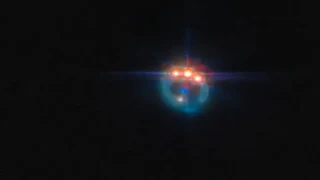Scientists have spotted a "ring studded with sparkling jewels" in deep space, using the James Webb Space Telescope.
The new image captures a distant quasar known as RX J1131-1231, which is located about 6 billion light-years from Earth.
The strong gravitational field of a nearby elliptical galaxy distorts the light of the quasar, creating what appear to be gemstones on a ring.
A quasar (or quasar-like star) is a hot gaseous region immediately surrounding a supermassive black hole, with a temperature of several hundred thousand degrees Celsius, emitting light and other radiation, and is an astronomical radio source. Therefore, a quasar is the most active astronomical object.
The quasar is powered by gas and dust falling into the galaxy's supermassive black hole, causing it to shine extremely brightly.
Scientists were able to observe RX J1131-1231 thanks to gravitational lensing, an effect that occurs when a massive object, such as a galaxy, bends light from a more distant source.
These gravitational lensing effects allow astronomers to study regions close to the black hole, according to a statement issued by the European Space Agency .
"Measurements of X-ray emission from quasars can provide an indication of how fast the central black hole is spinning, giving scientists important clues about how black holes grow over time," space agency officials said in a statement.
The elliptical galaxy that is the gravitational lens appears in the new James Webb image as a small blue dot in the center of the ring. The galaxy acts as a natural telescope, magnifying the light from the more distant quasar, which is too far away to study.
The new image was taken using the James Webb Space Telescope's Mid-Infrared Instrument (MIRI) as part of a larger study of dark matter and its distribution in the universe.
With these new observations and previous views from other telescopes, RX J1131-1231 is considered one of the best lensed quasars discovered so far, according to the European Space Agency.
Tags:
biggest mystery
james webb space telescope
magnificent jewels
mysterious objects
science
structure of universe





Informative
ReplyDeleteInformative
ReplyDelete